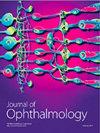Correlation between Corneal Volume and Corneal Biomechanics and Corneal Volume Significance in Staging and Diagnosing Keratoconus
IF 1.9
4区 医学
Q3 OPHTHALMOLOGY
引用次数: 0
Abstract
Purpose. To investigate the relationship between corneal volume (CV) at different zones and corneal biomechanics in keratoconus (KC) along with the significance of CV in diagnosing and staging KC. Methods. This prospective clinical study included 456 keratoconic eyes (Group B) and 198 normal eyes (Group A). Using the topographic KC classification method, Group B was divided into subgroups based on severity (mild, moderate, and severe). The CVs of the 3 mm, 5 mm, and 7 mm zones and biomechanical parameters were obtained by Pentacam and Corvis ST. The diagnostic utility of multirange CVs at different disease stages and severity was determined using a receiver operating characteristic (ROC) curve analysis. Results. The CV of the 7-mm zone had the strongest correlation with A1V, A2T, PD, DA ratio max (2 mm), DA ratio max (1 mm), ARTh, integrated radius, SPA1, and CBI . The CVs of the Group B subgroups were significantly lower than those of Group A for each diameter range . There were significant differences between the severe, mild, and moderate subgroups for the 3 mm zone (, all). The 3 mm zone CV exhibited better diagnostic ability in each group for distinguishing KC from the normal cornea (Groups A vs. B: area under the ROC curve (AUC) = 0.926, Groups A vs. B1: AUC = 0.894, Groups A vs. B2: AUC = 0.925, Groups A vs. B3: AUC = 0.953). Conclusion. The CV significantly decreased in keratoconic eyes. Progressive thinning in the 3 mm zone may be a valuable measurement for detecting and staging KC. Combining the CV examination with corneal biomechanical information may effectively enhance the ability to detect KC.角膜体积与角膜生物力学之间的相关性以及角膜体积在角膜炎分期和诊断中的意义
目的研究角膜塑形镜(KC)不同区域的角膜体积(CV)与角膜生物力学之间的关系,以及 CV 在诊断和分期 KC 中的意义。方法。这项前瞻性临床研究包括 456 只角膜炎眼(B 组)和 198 只正常眼(A 组)。采用地形学 KC 分级法,根据严重程度(轻度、中度和重度)将 B 组划分为若干亚组。通过 Pentacam 和 Corvis ST 获得了 3 毫米、5 毫米和 7 毫米区域的 CV 值和生物力学参数。通过接收器操作特征曲线(ROC)分析确定了多范围 CV 在不同疾病分期和严重程度下的诊断效用。结果显示7 毫米区的 CV 与 A1V、A2T、PD、DA 比值最大值(2 毫米)、DA 比值最大值(1 毫米)、ARTh、综合半径、SPA1 和 CBI 的相关性最强。在每个直径范围内,B 组亚组的 CV 值都明显低于 A 组。在 3 毫米区,重度、轻度和中度亚组之间存在明显差异(,全部)。在各组中,3 毫米区 CV 在区分 KC 和正常角膜方面表现出更好的诊断能力(A 组 vs. B 组:ROC 曲线下面积 (AUC) = 0.926,A 组 vs. B1 组:ROC 曲线下面积 (AUC) = 0.894,A 组 vs. B1 组:ROC 曲线下面积 (AUC) = 0.926):AUC = 0.894,A 组与 B2 组:ROC 曲线下面积(AUC) = 0.925,A 组与 B1 组:AUC = 0.894,A 组与 B2 组:AUC = 0.925,A 组与 B3 组:AUC = 0.925:AUC = 0.925,A 组与 B3 组:AUC = 0.953)。结论角膜病变眼的 CV 明显下降。3 毫米区域的逐渐变薄可能是检测和分期 KC 的重要测量指标。将 CV 检查与角膜生物力学信息相结合可有效提高检测 KC 的能力。
本文章由计算机程序翻译,如有差异,请以英文原文为准。
求助全文
约1分钟内获得全文
求助全文
来源期刊

Journal of Ophthalmology
MEDICINE, RESEARCH & EXPERIMENTAL-OPHTHALMOLOGY
CiteScore
4.30
自引率
5.30%
发文量
194
审稿时长
6-12 weeks
期刊介绍:
Journal of Ophthalmology is a peer-reviewed, Open Access journal that publishes original research articles, review articles, and clinical studies related to the anatomy, physiology and diseases of the eye. Submissions should focus on new diagnostic and surgical techniques, instrument and therapy updates, as well as clinical trials and research findings.
 求助内容:
求助内容: 应助结果提醒方式:
应助结果提醒方式:


